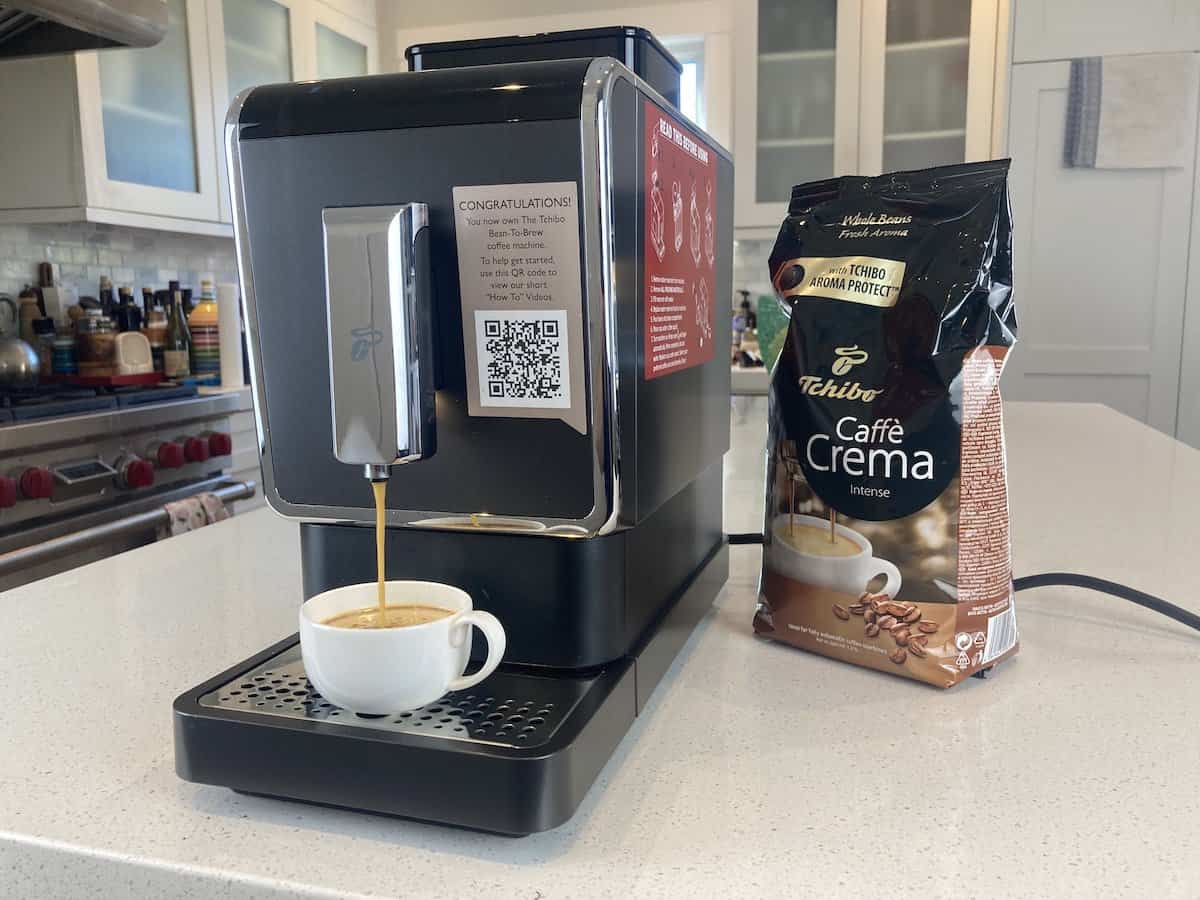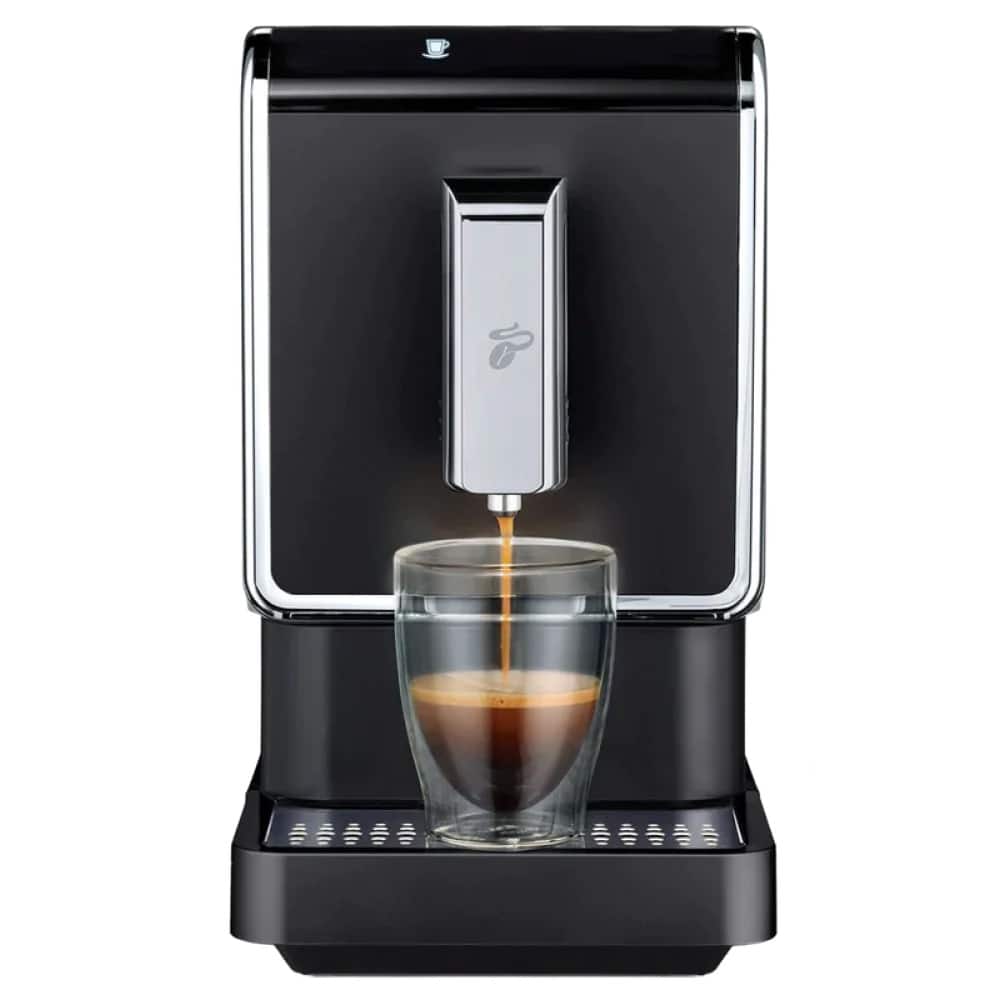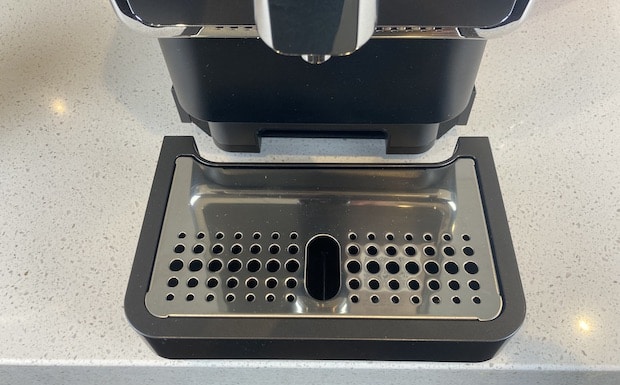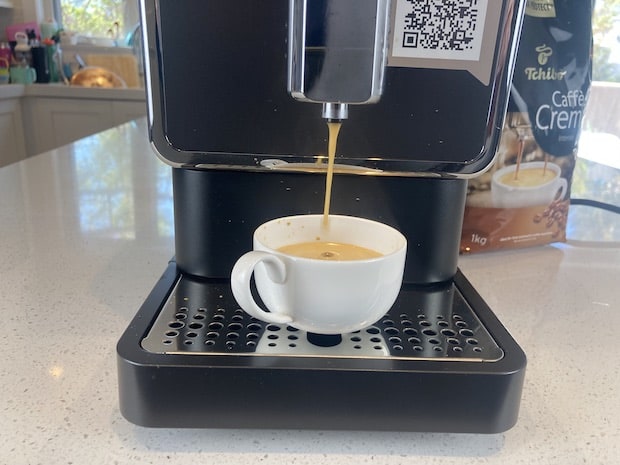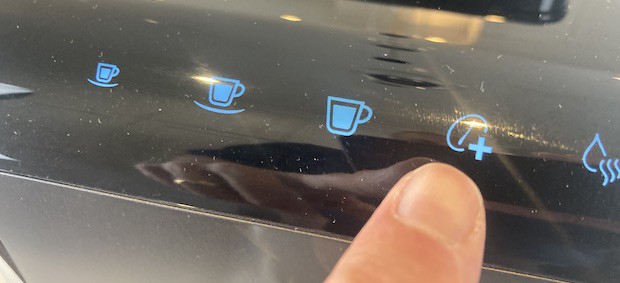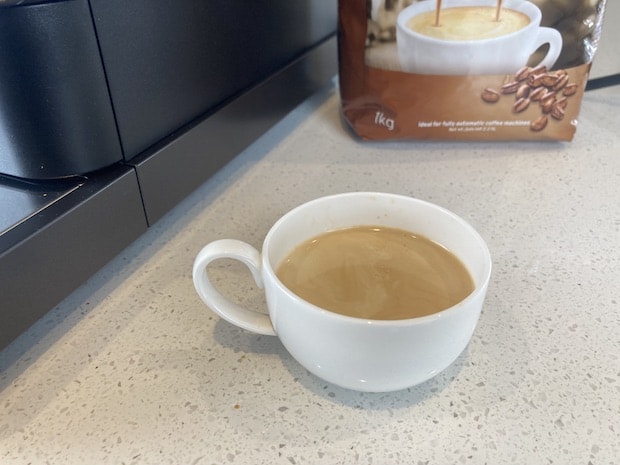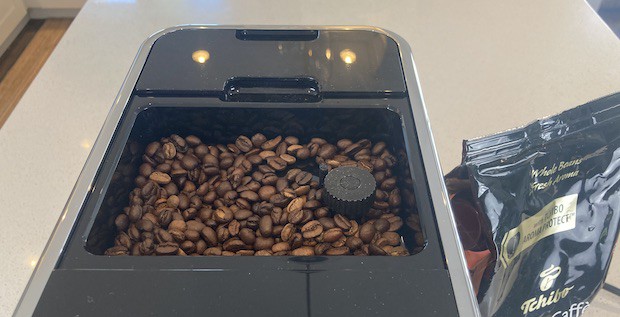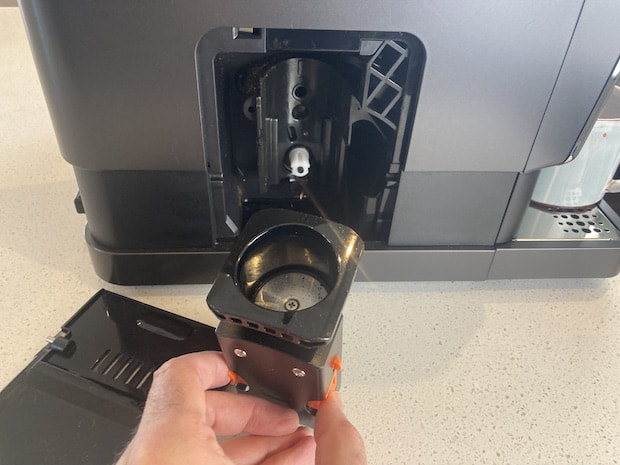Just so you know, as an Amazon Associate we earn from qualifying purchases made via bold red links, buttons or images.
Last Updated on December 3, 2023
Do you ever wish there was something in between a coffee pod machine and a real espresso machine?
The quick, easy convenience of single-serve coffee pods can’t be beat, but those empty pods sure do pile up—first in your kitchen, and then who knows where? It doesn’t seem very sustainable.
And a real espresso machine doesn’t get you out the door quickly in the morning, especially after you’ve waited 15 minutes for it to heat up and botched your first couple of shots!
The Tchibo Bean-To-Brew coffee machine might just be the in-between answer for you. It’s a fully automatic coffee and espresso machine that brews quick, easy, convenient coffee without the typical drawbacks and limitations of capsule machines.
To be perfectly transparent, this Tchibo coffee machine review probably wouldn’t have happened if Tchibo hadn’t reached out and offered to send me one of their machines for testing, but I’ve spent a few weeks with it now and I’m going to give you my honest impressions. After that, you can decide for yourself.
Things I Liked
- Single servings, no pods
- Freedom to choose any beans and grind them fresh
- Intuitive interface and ease of brewing
- ‘Intense’ setting to boost the strength of coffee
- Adjustable-height pour spout
- Compact size
Things I Didn’t Like
- Location of water tank and restrictive capacity
- Inside of machine can get messy with coffee grounds
- Magnetic drip tray detaches easily if not supported
- Somewhat limited drink choices
Who Makes It
Tchibo began in 1949 as a mail-order coffee company out of Hamburg, Germany. They began by selling packaged coffee beans through the mail and have been doing so for pretty much their entire history. They sell about a dozen different blends of whole bean coffee, and are known for their “Aroma Protect” technology that locks flavor into a bag of coffee beans using a screw cap.
In the latter half of the 20th century, Tchibo also opened up hundreds of coffeehouses all over Europe. Back in the ’70s when neither Starbucks nor Caffe Nero existed, you could find a Tchibo quite easily. They’re still around, but the majority are in Germany.
Tchibo didn’t start producing these coffee machines until 2016. They sell a number of different styles in Germany, but the Bean-To-Brew machine I tested is the only one they market in the U.S.
Place In The Market
With this machine, Tchibo seems to be targeting a segment of the market that wants a little more sophistication and sustainability than they can get with Nespresso or Keurig.
It’s a machine that brews as quickly and easily as Nespresso, but without the waste of spent coffee pods or the limited selection of whatever beans are packaged in the pods.
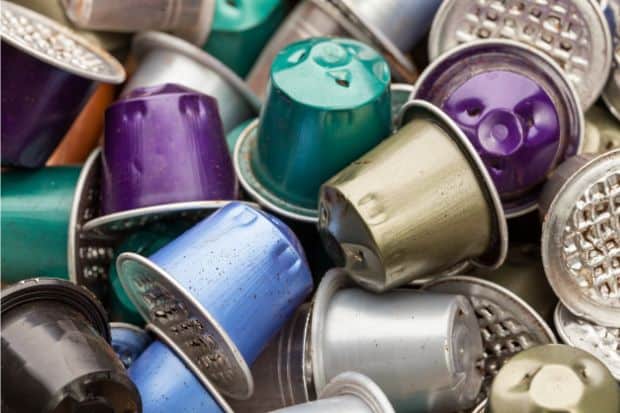
You can pick up any specialty beans you like at your local roaster, pour them into the top of your Tchibo, and enjoy them freshly ground and brewed all week long.
You’ll pay more for the privilege than you would for most Nespresso machines, but less than you would for most bean-to-cup machines. That’s because the Tchibo focuses on coffee and coffee only—there is no milk frothing or cappuccino at the touch of a button. You can brew an espresso in a demitasse, or a full cup of coffee of varying strengths, but that’s it.
Design and Build Quality
Considering all it can do, the Tchibo is a nice compact machine with a fairly small footprint. You shouldn’t have any problem finding space for this in your kitchen unless it’s already quite crowded.
I wouldn’t say the machine is a work of art, but it looks nice enough. It’s inoffensive and doesn’t draw too much attention to itself. The casing on the back and sides is matte black, while the top is much glossier. The edges feature chrome-colored trim, which I call “chrome-colored” because I don’t think it’s actually metal. The only metal on the machine seems to be the grate that covers the drip tray.
It’s hard to vouch for a machine’s durability when I’ve only had it for a few weeks, but I’ve seen nothing to make me question the Tchibo’s build. It’s mostly plastic, as a machine at this price point probably has to be, but the plastic is quite sturdy. All the removable parts fit well and are just as sturdy as the rest of the machine.
The drip tray attaches to the front of the machine via a magnet, which is kind of cool. It’s super easy to remove for cleaning.
The drawback is that the magnet isn’t strong enough to hold the drip tray in place without a counter supporting it. If you lift your machine, or slide it to the edge of the counter so that the drip tray is protruding, the drip tray will fall to the floor with a clang.
Above the drip tray is a spout that can be adjusted for eight. It slides smoothly along some sort of track when you raise and lower it.
The water tank at the back has a hinged handle with a cover attached, which you can use to carry it to the sink like a little pail. The handle and hinge felt solid, even when it was full.
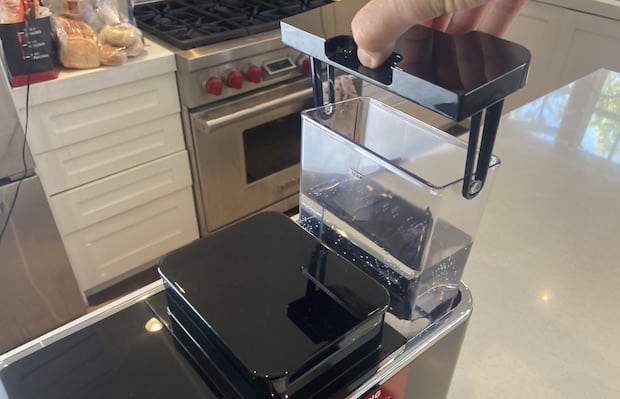
The heavy duty hardware is inside the machine: the grinder and brewing chamber.
The Tchibo grinds on demand using a built-in grinder that has conical stainless steel burrs. I didn’t get a look at this powerful grinder, and I’m not sure that’s even possible. You can hear it, though. (Don’t worry, it’s not unreasonably loud.)
The grinder deposits the grounds directly into the brewing chamber. To access the brewing chamber (for occasional cleaning), you pop open a side panel and then squeeze two little orange tabs on either side of the cylinder to detach it from the machine. It slides out easily and snaps back into place as it should. That piece has some heft to it.
Drinks You Can Make
As I mentioned earlier, there are no milky drinks here.
You can make espresso, and you can make a cup of coffee that Tchibo calls a caffè crema. This is essentially the same as a lungo or gran lungo. If you don’t know what a gran lungo is, stick with me.
Can It Make Regular Coffee?
The Tchibo doesn’t really make the sort of brewed drip coffee that we’re used to in North America. But its caffè crema is close enough.
Is It An Americano?
No, not really. An Americano is just a shot of regular espresso topped up with hot water after the fact. A caffè crema is an espresso that’s brewed using much more water than a regular espresso. But the water actually passes through the coffee grounds during the brewing process—that’s what distinguishes it from an Americano.
You can brew it in a larger size as well, which is more like a gran lungo, but they are all just espresso brewed with varying proportions of water.
Those drinks are the closest thing to a regular coffee that this machine will make. You might like it even better than regular coffee, though. It does come out with a nice crema on top.
Is It Real Espresso?
I think the Tchibo makes real espresso!
The Tchibo can pump at 19 bars of pressure. That’s the pressure at the actual pump—not necessarily the pressure in the brewing chamber where the espresso is being made. However, if we accept the common definition of espresso as being brewed at a minimum nine bars of pressure (usually between nine and 15), then it is likely brewing at well above nine bars even after the water has travelled from the pump to the brew chamber.
For that reason, I’m calling it real espresso. It sure tastes like real espresso.
What The Buttons Do
The Tchibo has four touch buttons across the top of machine that control the drinks you make.
- Espresso: makes a small cup of espresso
- Caffè crema: uses more water to brew a larger cup
- Large caffè crema: uses still more water to brew a much larger cup
- Intense: strengthens any of the above drinks by using more ground coffee
To boost the coffee intensity for any of these beverages, you simply click the “intense” button first and then select which size you want to brew.
The default sizes are 59 mL for espresso, 177 mL for caffè crema and 237 mL for a large caffè crema. You can change these default water volumes to suit your preference by following instructions in the manual.
How to Use It
The Tchibo is really easy to use. Your most difficult tasks are filling the water reservoir, which is no more difficult than filling a small pail from a tap, and pouring coffee beans into the hopper. That’s it.
Once those tasks are done, you’re almost ready to brew but there is one important step that you shouldn’t forget.
The machine runs a brief rinse cycle every time it is turned on from cold. This uses about one-third of a cup of water from the reservoir, so you need to make sure you put something under the spout when you first turn it on. Give it a couple of minutes to whirr and buzz, then it will release a little water into your cup. When the water stops, the control panel buttons light up indicating the machine is ready to brew. Dump that little bit of water and you’re good to go.
Simply choose which drink you want and an appropriate size cup, hit the button and wait. You’ll have your brew in less than a minute.
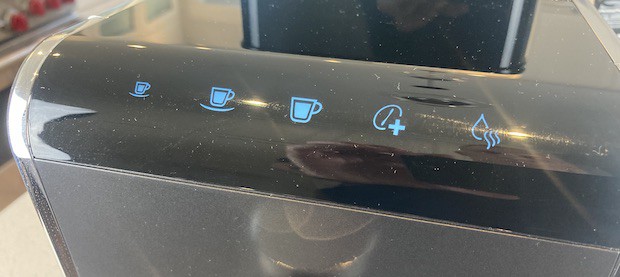
If you want a stronger brew, you have to touch two buttons: first the “intense” button, followed by the beverage you want.
Quality of Coffee
Of course, the quality of coffee you get out of the Tchibo is going to depend largely on the quality and freshness of the beans you put in. Having said that, here’s what I can tell you about my experiments.
Let’s start with the full-size drinks. I found the default cup to be a bit weak. That was easily rectified by hitting the “intense” button, which adds more coffee grounds to the brew. In both the regular and large sizes, a boosted brew was just about how I like it.
If I had one of these machines, I would re-program the water volumes so that they use a bit less water and produce the concentration I like. Then the “intense” setting could be really intense.
The coffee resembles what you would get from a Nespresso machine, but with a higher-quality crema on top. The crema on Nespresso can seem a bit inauthentic, particularly from the Vertuo line of machines which do a weird spinny thing to fabricate the foam on top of your coffee. The crema on a Tchibo cup is proper crema—quite thick, creamy and long-lasting.
Same with the espresso. It looks, feels and tastes like legitimate espresso, and packs a real punch if you give it that extra boost.
If you have a separate milk frother, try brewing two espressos in quick succession into the same cup and you’ve got a pretty good foundation to make a strong cappuccino or latte.
Experimenting with Beans
I did wonder whether this machine would allow the characteristics of different beans to shine through. I mean, if the selling point is that you can use whatever beans you want, then you don’t want the machine brewing them in such a way that all their uniqueness is flattened out and they all end up tasting the same.
To my relief, it was very easy to tell a generic dark roast from a high-quality, single-origin medium roast specialty coffee when both were brewed by the Tchibo. Even medium roasts of different origins were clearly distinct from each other.
The Tchibo doesn’t give you much flexibility to adjust your brewing method in hopes of coaxing different flavors out of your beans the way you can with a pour-over or AeroPress, but at least you can still tell different beans apart. That’s enough for all but the most hardcore connoisseurs.
Notable Features
Grind Adjustment
The Tchibo’s built-in burr grinder is adjustable. It only has five grind settings, but if you’re finding the coffee too sharp or too thin, that’s one variable you can play with.
You access it directly from the bean hopper, where it sticks up like a little post with a dial on top. It’s set to the second finest setting by default, so you can go one setting finer or three settings coarser. I couldn’t imagine wanting it any coarser, but your mileage may vary.
One quirk is that you have to adjust it while the grinder is operating. So brew yourself a coffee, and as soon as you hear that grinding noise coming from inside the machine, that’s the time to adjust the dial.
Water Tank With Filter
The Tchibo’s water reservoir holds just over 1,100 mL and has its own filter in the bottom. When the water tank is empty, the machine stops brewing and an indicator light flashes on top of the machine to let you know. As soon as you refill the tank, the brew cycle resumes.
I’m not gonna lie—I could have used a larger water container than this. Espresso drinkers probably won’t mind, but if you’re brewing full cups then the tank is only good for maybe four cups of coffee before you have to refill it.
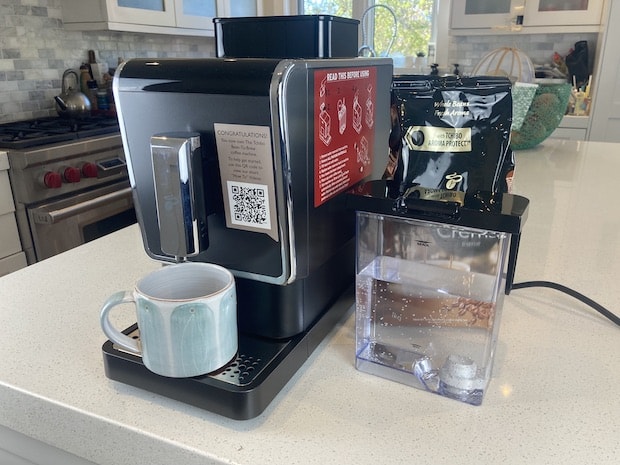
Another small quibble with the tank is that it’s difficult to remove in some situations. I mean, it lifts out easily enough, but it is located at the back of the machine and you must pull it up and clear of the machine to remove it for refills.
So, if you plan to keep your machine backed up against the wall underneath your kitchen cabinets, it’s going to be a pain to get this tank out to refill it. You’ll basically have to swivel the entire machine around and out from under the cabinets to lift the tank out.
I’d try to avoid burying it under a kitchen cabinet if you can. If your kitchen has an island, that’s the spot for it.
Adjustable Coffee Spout Height
I love this feature. The “tap” where your coffee emerges can slide up or down about an inch and a quarter to adjust to the height of your mug. It slides very smoothly.
I have a small Carter Everywhere mug which is about four and three-quarter inches tall, and it fits under the spout without any problem. You could fit a five-inch mug under it as well—you’d just need to angle it into place a bit.
Temporarily remove the magnetic drip tray and you’ll have about six and a half inches to play with. That’s a tall mug.
Coffee Bean Hopper Extension
The Tchibo’s bean hopper is a depressed cavity in the top of the machine that holds about 160 grams of coffee beans. However, the machine comes with an extra piece that allows you to expand the hopper’s capacity. You just slide it into place in the bean hopper and it basically extends the walls an extra inch and a half up the side. With that in place, the hopper will hold 300 grams.
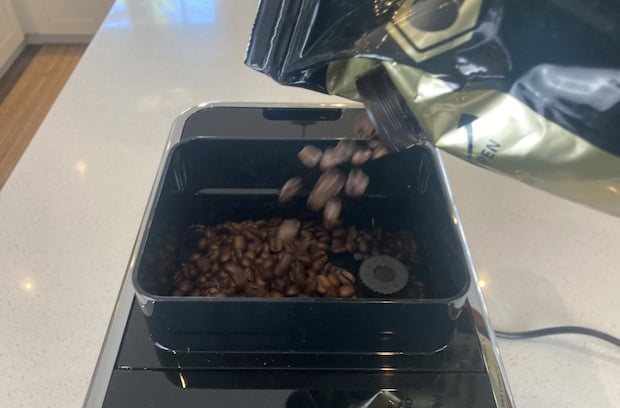
Keep in mind that bags of beans should be opened as close to brew time as possible, so if you fill the hopper with 300 grams every time, your coffee won’t be too fresh by the time you get to the beans on the bottom. I’d just restock the hopper a little at a time.
An indicator light on top of the machine lights up whenever the supply of beans in the hopper is low.
Automatic Switch-Off
By default, the Tchibo powers down into standby mode after 10 minutes of inactivity, which is a nice energy-saving feature. You can adjust the length of time to 20, 30 or 120 minutes by following instructions in the manual.
Cleaning and Maintenance
You need to take care of a few things if you want to keep this machine in top shape. We’ll start with the chores that must be done most frequently, and work our way down.
Emptying the Grounds Tray
There’s a tray in the base of the machine that collects the used grounds—or “spent pucks”—after each brew. It will fill up after about 10 brews, and an indicator light on top of the machine will let you know it’s time to empty it. You should probably do this every day or two, though, because coffee pucks can get moldy.
It slides out easily from the front of the machine. (Remove the magnetic drip tray first, if that helps.)
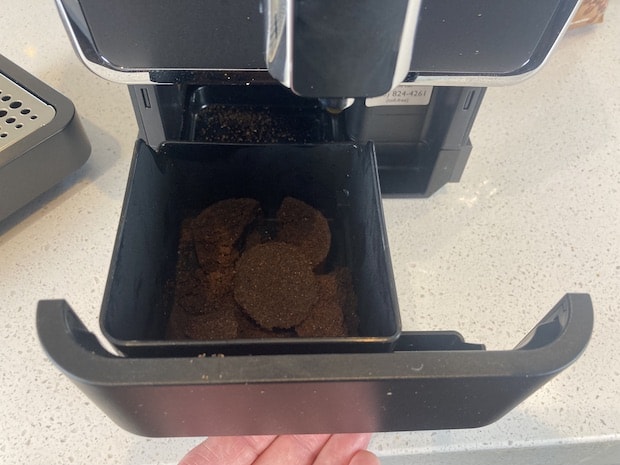
Once it’s out, it separates into two pieces, one of which holds most of the used grounds. Just dump them in your compost and give both pieces a good rinse, then wipe them dry before reassembling and sliding it back into the machine.
It probably wouldn’t hurt to give these pieces the soap-and-water treatment every week or two.
Rinsing the Brew Chamber
I mentioned earlier the little side panel that contains the brew chamber. Once a week, you should pop this open and pinch those orange tabs to release the brewing cylinder. Run it under hot water for a while to clear it of any old coffee grounds, then dry it well and re-insert it.
You’ll probably notice a few spilled coffee grounds inside the bottom of the machine as you’re doing this. I’m not sure whether they come from the grounds tray overflowing, or are spilled during transfer from the grinder into the brew chamber. Either way, just keep an eye on it and you can tidy up those ground beans with some dampened paper towel as required.
Water Tank
You’ll probably fill the tank a couple of times a week. No need to wash it each time, but like the grounds tray, you should probably hand wash it with soap and water every week or two to keep it looking its best. Remove the filter first, which is easy to put back in place. You should NOT put the water tank in the dishwasher.
Descaling
Finally, the Tchibo Bean-To-Brew has to be descaled like any other pump machine. Descaling means running an acidic solution through the machine to clear it of any mineral deposits that have built up in the tubes as a result of your water.
Fortunately, there’s another warning light on top for this, so you’ll know when it’s time to descale (it’s typically every few months). Don’t put this off! The descaling process only takes about 15 minutes and is outlined in the manual.
Specifications
| Grinder | Stainless steel conical burrs |
| Dimensions | 12.4″ H x 7.1″ W x 15.7″ D |
| Weight | 18.1 pounds |
| Preset brew volumes | 59 mL, 177 mL, 237 mL |
| Power | 1,350 watts |
| Pump pressure | 19 bars |
| Noise level | 80 dB maximum |
The Bottom Line
I like what the Tchibo is: a coffee machine with a compact design that makes it very easy to enjoy extremely fresh coffee every morning—even when you can’t yet pry your eyes open.
Yes, Keurig and Nespresso also do this. But let’s face it, Keurig coffee can be a bit sketchy and Nespresso is like, “Drink Nespresso-brand coffees or drink nothing!” Now, imagine being able to brew the same style of coffee as Nespresso, but using the fresh beans of your choice from any of the finest roasters around. That’s the freedom the Tchibo Bean-To-Brew gives you.
Is it worth a price tag that’s three times the cost of some Nespresso machines? Well, that’s up to you, but I can assure you that many people buy bean-to-cup coffee machines that cost twice as much as the Tchibo.
And I’d pay quite a bit to never have to recycle a bag of spent coffee capsules again.

